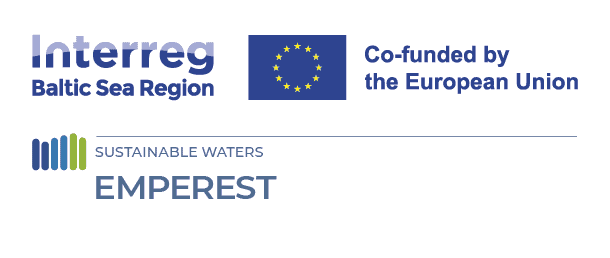
EMPEREST on the road to learn about latest wastewater treatment technology
15 December 2023
The excursion was organised by the Berlin University of Technology team within the activities on assembling a training package on monitoring and removal of PFAS and other organic micropollutants.
The wastewater treatment plants (WWTPs) that we visited apply three different effluent post-treatment technologies: ozonation, granular activated carbon (GAC) filtration and treatment with powdered activated carbon (PAC). The study visits brought together 23 project members from Estonia, Finland, Germany, Lithuania, and Poland. Seeing the advanced technologies in action, explained by the local experts, and having the possibility to discuss their inner workings and ask a ton of questions was extremely beneficial for the EMPEREST partners. This exchange of information was especially relevant to the project as some of the technologies will indeed be tested in our own technology pilots, aiming at finding efficient and cost-effective ways for removing organic micropollutants from the effluent. In addition, the informative presentations and short interviews given by the operators answering key questions were recorded and will be used for training purposes.
Our journey started in Zürich, where we visited the WWTP Werdhölzli, covering a catchment area of 482,000 Population Equivalent (PE). Interestingly, the Swiss people took a public vote and instated a new water conservation legislation already in 2016, requiring micropollutants to be removed from larger WWTPs in the region. Being the biggest wastewater treatment plant in the whole country, WWTP Werdhölzli was one of the first to adapt to the new legislation and has now been running the largest ozonation unit in Europe for a few years. Their approach to ozonation is unique also in the sense that the plant produces the necessary oxygen for ozone generation directly on-site, using the pressure swing adsorption (PSA) process to enrich oxygen from air. Questions related to e.g. the production of ozone, energy consumption and the ozonation process itself were thoroughly discussed with the local operators, as were the total costs of the installation and funding mechanisms present for such installations in Switzerland.
“We chose ozonation because we knew we could produce the oxygen and ozone on site so the whole process would be fully in our own hands. We are very satisfied with the elimination performance,” shared Mr. Daniel Rench, managing director of the Werdhölzli WWTP in Zürich.
Next on our path was Immendingen, where the local WWTP differs considerably in size from Werdhölzli, covering only about 25,000 PE. The plant, located by the Danube river, uses granular activated carbon (GAC) filtration for advanced effluent treatment. Although the EU regulations are not demanding micropollutant removal yet, the technology in the WWTP was installed to protect the Danube and make sure micropollutants are not getting into the drinking water production systems, which are using the river for their water supply. The GAC adsorbs micropollutants, a process which is facilitated by its porous structure and has proven to be very promising in organic micropollutant removal, including PFAS. To our surprise, the GAC lifetime in the filter turned out to be significantly higher than we expected, with the material still reaching very high adsorption rates after more than 2 years of continuous operation.
“The GAC filtration was chosen as the most appropriate post-treatment technology for a medium sized treatment plant. There are seven micropollutant parameters in our list and currently we are above 90% total elimination of all parameters,” emphasized Mr. Sebastian Platz, consultant at Sweco, planning of the GAC unit at Immendingen WWTP.
Our final visit was to the Steinhäule WWTP in Ulm which covers a catchment area of 440,000 PE in several municipalities and from which the cleaned wastewater also flows into the Danube river. At Steinhäule plant, we had the chance to discover the “Ulmer process”, which uses powdered activated carbon (PAC) treatment with a subsequent sand filtration system for the micropollutant removal. As the name might suggest, the whole process was developed on-site by local experts, during an extensive 8-year pilot study. Similar to GAC filtration applied in Immendingen, the removal of micropollutants is based on the adsorption on activated carbon. However, the PAC is not fixed into a filter but is mixed with the wastewater, thus providing more flexibility regarding the dosage. In addition, due to the smaller size of the particles, a larger surface area is available for the adsorption. Part of the PAC is exchanged on every cycle and incinerated locally at the WWTP, generating heat for the processes and buildings.
“People are in favour of the investment in PAC technology because we promise that with only 5€ per year from each resident, we can reduce micropollutants by more than 80 % and improve water quality of the Danube,” highlighted Mr. Christian Hiller, Department manager, Steinhäule WWTP in Ulm.
All three advanced technologies offer novel ways to remove micropollutants from wastewater effluents, but unfortunately, data about PFAS removal was very scarce. This was partly due to very low influent concentrations of PFAS at those specific locations, which unfortunately is not the case for many other WWTPs in the region. The missing relevant legislation was an additional reason. In order to discover the full potential of these technologies, the EMPEREST pilots will be equipped by both ozonation and GAC filters, to see not only their efficiency as stand-alone technologies, but also in combination, and to explore the cost-effectiveness of these micropollutant removal options. As the EMPEREST project mobile pilot containers start making their way around the Baltic Sea in early 2024, our partners and experts are now equipped with a lot of relevant knowledge about the respective processes and details about their operation from technological forerunners in Europe. Be on the look-out for the results of our piloting – planned to be published in the second half of 2025!
Written by: Markus Raudkivi, HELCOM, Nikolaos Tzoupanos, Berlin University of Technology, and Lotta Lehti, UBC Sustainable Cities Commission








